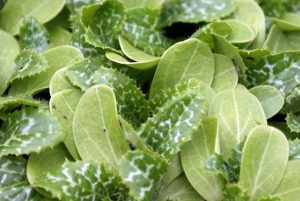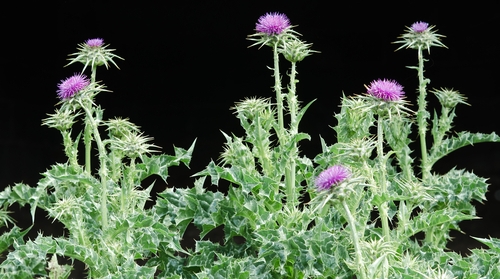Legend has it that when the Virgin Mary was breastfeeding the baby Jesus a few drops of her milk fell and left their mark upon the leaves of a thistle which is why it is known as milk thistle (other common names include holy thistle and Mary thistle).
The leaves of the milk thistle are indeed characterised by whitish patches which resemble milk.
Milk thistle has been recognised as a medicinal plant since antiquity and is mainly used in modern naturopathy in the treatment of liver damage.
It is native to the dry soils of southern Europe, northern Africa and western Asia but has now also spread into South and North America, Australia and central Europe. The plant grows up to 1.5 metres tall and belongs to the composite family (asteraceae). Its flowering season runs from June to September. The toothed, thorny leaves shine green and also feature the whitish patches mentioned. In contrast, the spherical flowers are a striking crimson colour and the smooth, elongated seeds (the fruit of the plant) are dark brown [1].
Application in naturopathy:
In complementary medicine it is the seeds of the milk thistle that are used. Milk thistle’s active ingredients are mainly found in a a compound known as silymarin (comprised of the so-called flavonolignans silybin, isosilybin, silychristin, silydianin). The seeds are not particularly useful when consumed in the form of a tea on account of their fat-soluble properties. For this reason, mainly dry or liquid extracts are used – also as a finished medicinal product. The recommended daily dose of silymarin is around 300 mg, divided into 3 doses for a period of 4 – 8 weeks [2].
Indications for use:
The Commission E scientific advisory board of the German Federal Institute for Drugs and Medical Devices (BfArM) endorses the use of milk thistle in the case of toxic liver damage (triggered by alcohol, viruses, toxins or medicinal products such as paracetamol) and cirrhosis of the liver [3]. The European Medicines Agency (EMA) comes to similar conclusions and also describes the traditional (not scientifically-proven) use of milk thistle seeds for non-specific stomach complaints (bloating and flatulence) [2]. These assessments match with the way patients use milk thistle as well as the prescribing practices of doctors working in the area of naturopathy and homoeopathic practitioners.
As part of our complementary medicine consultation service at the Munich Tumour Centre milk thistle is especially used when a patient expresses the wish to “detoxify” the liver after chemotherapy. From a medical perspective such a “detoxification” is only necessary in the rarest of cases. Nevertheless, in the case of pre-existing or new appearance of signs of liver strain (for instance an increase in so-called liver enzymes in the blood), the use of milk thistle can make very good sense. In this connection it is extremely advantageous that milk thistle poses a low risk of interaction with other medicines, especially with most cancer medicines [4]. The latest research findings provide hope that milk thistle could also have a protective effect on cells of the heart [5] and kidneys [6]. These effects could be useful for cancer patients who have to undergo cancer therapy which puts a strain on the heart or kidneys.
There are also exciting developments concerning research investigating the direct cancer-inhibiting effect of milk thistle. At present, for example, investigations are taking place into whether milk thistle can positively influence the course of prostate or liver cancer [7, 8].
Beyond the above-mentioned indicators, research is also currently taking place on the positive effect of milk thistle in the case of blood lipid levels, atherosclerosis (also of the heart), diabetes and Alzheimer’s [9].
Milk thistle seeds can occasionally cause flatulence and stomach ache but aside from this preparations of milk thistle are considered to be easy to digest. Milk thistle should be avoided if you are aware of an allergy to composite plants. Furthermore, during pregnancy and breastfeeding there are potential risks for the child which have not been investigated thoroughly enough as yet [2].
In order to interpret results from studies correctly and ensure that they are adjusted to your personal situation, for your own safety, it is vital always to seek expert advice prior to taking a preparation of milk thistle.
Sources:
[1] http://phytosciences.org/de/pflanzenportraets/mariendistel
[4] Kawaguchi-Suzuki M, Frye RF, Zhu HJ1, Brinda BJ, Chavin KD, Bernstein HJ, Markowitz JS. The effects of milk thistle (Silybummarianum) on human cytochrome P450 activity.Drug MetabDispos. 2014 Oct;42(10):1611-6. doi: 10.1124/dmd.114.057232. Epub 2014 Jul 15.
[5] Razavi BM, Karimi G, Protective effect of silymarin against chemical-induced cardiotoxicity. Iran J Basic Med Sci. 2016 Sep;19(9):916-923.
[6] Rafieian-Kopaie M, Nasri H. Silymarin and diabetic nephropathy. J Renal Inj Prev. 2012 Jan 1;1(1):3-5. doi: 10.12861/jrip.2012.02. eCollection 2012.
[7] Vue B, Chen QH. The Potential of Flavonolignans in Prostate Cancer Management. Curr Med Chem. 2016;23(34):3925-3950.
[8] Polachi N, Bai G, Li T, Chu Y, Wang X, Li S, Gu N, Wu J, Li W, Zhang Y, Zhou S, Sun H, Liu C. Modulatory effects of silibinin in various cell signaling pathways against liver disorders and cancer – A comprehensive review. Eur J Med Chem. 2016 Nov 10;123:577-95. doi: 10.1016/j.ejmech.2016.07.070. Epub 2016 Jul 29.
[9] Bahmani M, Shirzad H, Rafieian S, Rafieian-Kopaei M. Silybummarianum: Beyond Hepatoprotection. J Evid Based Complementary Altern Med. 2015 Oct;20(4):292-301. doi: 10.1177/2156587215571116. Epub 2015 Feb 16.
